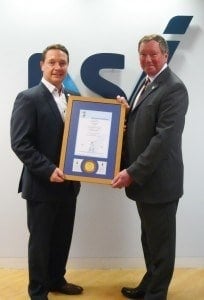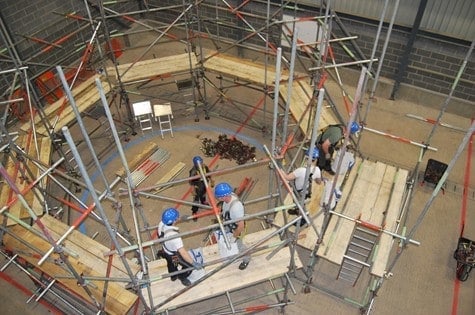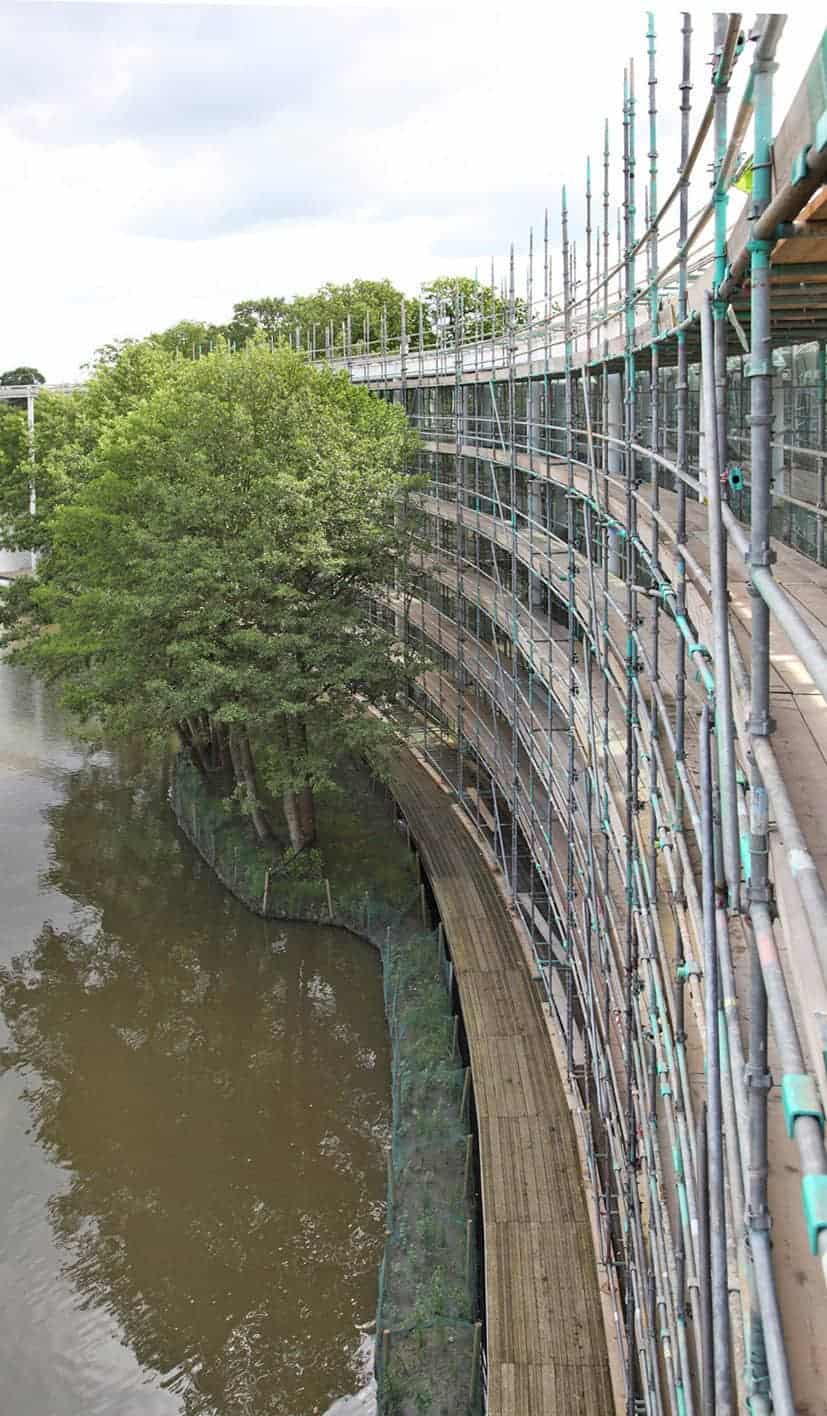TG20:13 receives a positive response from a batch of regional NASC meetings..
The new TG20:13 guidance document was recently unveiled with a presentation at a batch of NASC (National Access & Scaffolding Confederation) regional meetings for its members. The new guidance and eGuide received an overwhelming positive response from key personnel from within the UK scaffolding industry. The eGuide that complements the main TG20:13 document has been designed and developed by CADS who are the makers of the world leading scaffolding software SMART Scaffolder. The guidance will see some major changes to previous versions of the document one such change being all standard scaffolds in TG20:13 will be fully proven by design and calculations. This will undeniably remove some of the burden for design currently experienced which in-turn will give more power to the scaffolder rather then the scaffold designer which we see in the current TG20:08 guidance.Knock on effect?
After TG20:13 is released later on this year, there will no-doubt be a decline in scaffolds needing a design, but could this have a knock on effect within the scaffolding design industry with its workload and business revenue ? We asked one of the most prevalent scaffold design company’s in the UK 48.3 Scaffold Design Ltd for a comment on the new TG20:13 document and eGuide and how it will effect the industry. Managing Director, Ben Beaumont from 48.3 Scaffold Design Ltd said:A wider impact ?
A common feeling amongst the industry is that TG20:13 will also be a really useful tool especially for main contractors. With the new ground breaking eGuide main contractors will be able to see a visual design on a computer screen of what they should be getting before the scaffolding work on site begins. The release date for this eagerly awaited guidence was originally set for spring time. But as NASC and CADS want everything perfect before release this date has now changed to the summer. What we do know is the eGuide comes with the main TG20:13 document as standard and is not sold separately. The price for the guidance is still to be confirmed but will be cheaper for NASC members. Written By Daniel Norton.Let us know your thoughts on the new guidance and how you think it will impact the industry in the comments below.







 Panthera are the first UK scaffolding alarms provider to comply with NSI’s new Code of Practice for the Design, Installation & Maintenance of Scaffolding Alarm Systems (NCP 115) under its premier NACOSS Gold Scheme.
The installation of scaffold alarms is a growing market, but to date has never been the subject of any form of self regulation or industry-specific standards. The Code of Practice NCP 115, introduced by NSI in January this year, provides an industry benchmark to which scaffold alarm systems providers can now aspire and adhere. The specification of NCP 115 will undoubtedly help to mitigate risk – protecting buildings as well as the assets within. The new code also aims to eliminate malpractice and raise the standards in the industry, opening up a new market for electronic security installers.
Awareness of NCP 115 has been gaining momentum, particularly amongst insurers and specifiers where it has been evidenced that the Code is now being specified. NSI has also received an influx of enquires from electronic security providers interested in this new NSI scope of approval.
NSI Chief Executive, Jeff Little, OBE, commented “NCP 115 tackles an entirely new area in a sector that previously had no set Standards or best practice. I heartily congratulate Panthera Group for leading the way in this niche security sector. Their NACOSS Gold approval with NSI is very well deserved and presenting them with their Gold medal has really commemorated the achievement today. I wish Panthera every success in the future.”
Neal James, Managing Director of Panthera Group commented “Today has been a real celebration of our NACOSS Gold Approval. The framed medal will take pride of place in our offices, highlighting our significant achievement in becoming the UK’s first NSI approved Scaffold Alarm Installer”.
James continues “Now that NSI has written a Code of Practice, paired with our own commitment to raising the standards within our industry, we are confident that it sets a precedent for others to follow. The Code provides surveyors, contractors, home owners and commercial organisations with the reassurance that their scaffold alarm systems have been designed, installed and certificated to a high standard, ultimately helping to mitigate their risk and liability.”
Panthera are the first UK scaffolding alarms provider to comply with NSI’s new Code of Practice for the Design, Installation & Maintenance of Scaffolding Alarm Systems (NCP 115) under its premier NACOSS Gold Scheme.
The installation of scaffold alarms is a growing market, but to date has never been the subject of any form of self regulation or industry-specific standards. The Code of Practice NCP 115, introduced by NSI in January this year, provides an industry benchmark to which scaffold alarm systems providers can now aspire and adhere. The specification of NCP 115 will undoubtedly help to mitigate risk – protecting buildings as well as the assets within. The new code also aims to eliminate malpractice and raise the standards in the industry, opening up a new market for electronic security installers.
Awareness of NCP 115 has been gaining momentum, particularly amongst insurers and specifiers where it has been evidenced that the Code is now being specified. NSI has also received an influx of enquires from electronic security providers interested in this new NSI scope of approval.
NSI Chief Executive, Jeff Little, OBE, commented “NCP 115 tackles an entirely new area in a sector that previously had no set Standards or best practice. I heartily congratulate Panthera Group for leading the way in this niche security sector. Their NACOSS Gold approval with NSI is very well deserved and presenting them with their Gold medal has really commemorated the achievement today. I wish Panthera every success in the future.”
Neal James, Managing Director of Panthera Group commented “Today has been a real celebration of our NACOSS Gold Approval. The framed medal will take pride of place in our offices, highlighting our significant achievement in becoming the UK’s first NSI approved Scaffold Alarm Installer”.
James continues “Now that NSI has written a Code of Practice, paired with our own commitment to raising the standards within our industry, we are confident that it sets a precedent for others to follow. The Code provides surveyors, contractors, home owners and commercial organisations with the reassurance that their scaffold alarm systems have been designed, installed and certificated to a high standard, ultimately helping to mitigate their risk and liability.” 

 A project to refurbish a highly distinctive office building in Woking has underlined the versatility of the scaffolding services supplied by Harsco Infrastructure, who provided access to the entire building using its Cuplok scaffold system. This provided safe, effective access for the various trades who needed to work on the building’s exterior facades, giving wide, clear work decks free from obstructions and trip-hazards.
The building presented a number of challenges including a long, curved elevation adjacent to water and lightweight exterior walls that required the scaffolding to be self-supporting. “The Cuplok system was ideal for this project,” comments Harsco’s Site Services Manager, Sean Byles. “Despite the fact that the building has a sweeping curve to its main elevation, Cuplok allowed us to build a structure that followed the profile of the building precisely and provided excellent access.” The systemfeatures aunique node point which allows up to four horizontal components to be connected at any angle in one simple fastening action. This allowed the scaffolding to accommodate the curve and still be erected considerably faster than traditional scaffolding.
The building’s two end elevations also presented their own challenges, as Sean explains. “These facades have steel louvered screens which stand beyond the glazed wall. Although these are actually fixed in position, they were not robust enough to tie the scaffolding into. We therefore erected the scaffolding on both sides of the louvers and linked the structures together to create the required degree of stability and safety.”
In other areas where the scaffolding could not be tied to the building, the CUPLOK structures were braced by tower assemblies incorporating counter-weight kentledge to provide stability. The perimeter scaffold also incorporated a large access staircase, a mechanical hoist and rubbish removal towers.
The 6-storey building sits on the bank of a large lake – a factor which influenced the system design that Harsco created. “Fortunately the lakeside timber decking and its steelwork support structure had been recently replaced,” adds Sean. “This meant that we had a firm base on which to build, but space was still at a premium, and the presence of the water meant that safety was, as ever, a vital consideration.”
Safety is a key characteristic of Harsco’s Cuplok system, which features advanced guardrails and steel boards that provide maximum protection on site. This helps create fully integrated, systemised access solutions, and Harsco continues to add new components to the system to expand the versatility it offers.
A project to refurbish a highly distinctive office building in Woking has underlined the versatility of the scaffolding services supplied by Harsco Infrastructure, who provided access to the entire building using its Cuplok scaffold system. This provided safe, effective access for the various trades who needed to work on the building’s exterior facades, giving wide, clear work decks free from obstructions and trip-hazards.
The building presented a number of challenges including a long, curved elevation adjacent to water and lightweight exterior walls that required the scaffolding to be self-supporting. “The Cuplok system was ideal for this project,” comments Harsco’s Site Services Manager, Sean Byles. “Despite the fact that the building has a sweeping curve to its main elevation, Cuplok allowed us to build a structure that followed the profile of the building precisely and provided excellent access.” The systemfeatures aunique node point which allows up to four horizontal components to be connected at any angle in one simple fastening action. This allowed the scaffolding to accommodate the curve and still be erected considerably faster than traditional scaffolding.
The building’s two end elevations also presented their own challenges, as Sean explains. “These facades have steel louvered screens which stand beyond the glazed wall. Although these are actually fixed in position, they were not robust enough to tie the scaffolding into. We therefore erected the scaffolding on both sides of the louvers and linked the structures together to create the required degree of stability and safety.”
In other areas where the scaffolding could not be tied to the building, the CUPLOK structures were braced by tower assemblies incorporating counter-weight kentledge to provide stability. The perimeter scaffold also incorporated a large access staircase, a mechanical hoist and rubbish removal towers.
The 6-storey building sits on the bank of a large lake – a factor which influenced the system design that Harsco created. “Fortunately the lakeside timber decking and its steelwork support structure had been recently replaced,” adds Sean. “This meant that we had a firm base on which to build, but space was still at a premium, and the presence of the water meant that safety was, as ever, a vital consideration.”
Safety is a key characteristic of Harsco’s Cuplok system, which features advanced guardrails and steel boards that provide maximum protection on site. This helps create fully integrated, systemised access solutions, and Harsco continues to add new components to the system to expand the versatility it offers.


